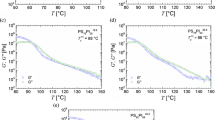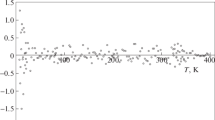Abstract
The thermally stimulated depolarization current (TSDC) technique has been used to study the slow molecular mobility of polysulfone in the glassy state and in the glass transformation region, i.e., in the temperature ranging from −155 to 183 °C. Since the polysulfone is a rigid polymer without polar side-groups, a broad and low-intensity secondary relaxation was detected in the temperature region from −120 °C up to the glass transition; the activation energy of the motional modes of this secondary relaxation is in the range between 35 and 100 kJ mol−1. The glass transition temperature of polysulfone provided by the TSDC technique is T M = T g = 176 °C (at 4 °C min−1). The relaxation time at this temperature is τ(T g) = 33 s and the fragility index was found to be m = 91. Our results are compared with literature values obtained by dynamic mechanical analysis and by dielectric relaxation spectroscopy. The amorphous polysulfone was also characterized by DSC; a glass transition signal with an onset at T on = 185.5 ± 0.3 °C (heating rate 10 °C min−1) was detected, with ΔC p = 0.21 ± 0.01 J g−1 °C−1.




Similar content being viewed by others
References
Bowry SK, Krieter DH. Dialysis membranes today. Int J Art Organs. 2002;25:447–60.
Susanto H, Ulbricht M. Characteristics, performance and stability of polyethersulfone ultrafiltration membranes prepared by phase separation method using different macromolecular additives. J Memb Sci. 2009;327:125–35.
Vico S, Palys B, Buess-Herman C. Hydration of a polysulfone anion-exchange membrane studied by vibrational spectroscopy. Langmuir. 2003;19:3282–7.
Zornoza B, Irusta S, Téllez C, Coronas J. Mesoporous silica sphere-polysulfone mixed matrix membranes for gas separation. Langmuir. 2009;25:5903–9.
Gu X, Kuang Y, Guo X, Fang J, Ni Z. Synthesis and drug release properties of poly(ethylene oxide) segmented polysulfone copolymers. J Control Release. 2008;127:267–72.
Kim Y, Haftel VK, Kumar S, Bellamkonda RV. The role of aligned polymer fiber-based constructs in the bridging of long peripheral nerve gaps. Biomaterials. 2008;29:3117–27.
Silva AI, Mateus M. Development of a polysulfone hollow fiber vascular bio-artificial pancreas device for in vitro studies. J Biotechnol. 2009;139:236–49.
Placek V, Hnat V, Pejsa R, Kohout T. Testing of polysulfone for applications in nuclear facilities. J Appl Polym Sci. 2008;109:2395–9.
Fried JR, Letton A, Welsh WJ. Secondary relaxation processes in bisphenol-A polysulphone. Polymer. 1990;31:1032–7.
Aitken CL, McHattie JS, Paul DR. Dynamic mechanical behavior of polysulfones. Macromolecules. 1992;25:2910–22.
Cangialosi D, Alegría A, Colmenero J. On the temperature dependence of the nonexponentiality in glass-forming liquids—art. no. 124902. J Chem Phys. 2009;130:24902.
Allen G, McAinsh J, Jeffs GM. Relaxation phenomena in some aromatic polymers: effect of water content on the low temperature relaxation. Polymer. 1971;12:85–100.
Labahn D, Mix R, Schonhals A. Dielectric relaxation of ultrathin films of supported polysulfone. Phys Rev E. 2009;79:011801–9.
Alegría A, Colmenero J, Mari PO, Campbell IA. Dielectric investigation of the temperature dependence of the nonexponentiality of the dynamics of polymer melts. Phys Rev E. 1999;59:6888–95.
Makaya G. Dielectric γ losses in polysulphone and polyethersulphone. Polymer. 1978;19:601–2.
Moura Ramos JJ, Correia NT, Diogo HP. Rotational mobility in a glassy crystal studied by thermally stimulated depolarisation currents (TSDC). An experiment for the physical chemistry laboratory. Chem Educ. 2009;14:175–9.
Teyssedre G, Lacabanne C. Some considerations about the analysis of thermostimulated depolarization peaks. J Phys D Appl Phys. 1995;28:1478–87.
van Turnhout J. Thermally stimulated discharge of polymer electrets. Amsterdam: Elsevier; 1975.
Chen R, Kirsch Y. Analysis of thermally stimulated processes. Oxford: Pergamon Press; 1981.
Sauer BB. Thermally stimulated currents: recent developments in characterisation and analysis of polymers. In: Cheng SZD, editor. Applications to polymers and plastics. Amsterdam: Elsevier; 2002. p. 653–711.
Gun’ko VM, Zarko VI, Goncharuk EV, Andriyko LS, Turov VV, Nychiporuk YM, Leboda R, Skubiszewska-Zieba J, Gabchak AL, Osovskii VD, Ptushinskii YG, Yurchenko GR, Mishchuk OA, Gorbik PP, Pissis P, Blitz JP. TSDC spectroscopy of relaxational and interfacial phenomena. Adv Colloid Interface Sci. 2007;131:1–89.
Bucci C, Fieschi R. Ionic thermoconductivity. Method for the investigation of polarization in insulators. Phys Rev Lett. 1964;12:16–9.
Bucci C, Fieschi R, Guidi G. Ionic thermocurrents in dielectrics. Phys Rev. 1966;148:816–23.
Alegría A, Goitiandia L, Colmenero J. On the interpretation of the TSDC results in the study of the alpha-relaxation of amorphous polymers. Polymer. 1996;37:2915–23.
Goitiandia L, Alegría A. Physical aging of poly(vinyl acetate). A thermally stimulated depolarization current investigation. J Non Cryst Solids. 2001;287:237–41.
Viciosa MT, Pires G, Moura Ramos JJ. Is the Kohlrausch function a good tool to account for nonexponentiality in thermally stimulated depolarisation currents (TSDC) data treatment? Chem Phys. 2009;359:156–60.
Viciosa MT, Pires G, Moura Ramos JJ. Revisitation of the molecular mobility of the amorphous solid 4,4′-methylenebis(N,N-diglycidylaniline) (MBDA): new contributions from the TSDC technique. J Mol Liq. 2009;148:114–9.
Pinto SS, Moura Ramos JJ, Diogo HP. The slow molecular mobility in poly(vinyl acetate) revisited: new contributions from thermally stimulated currents. Eur Polym J. 2009;45:2644–52.
Moura Ramos JJ, Taveira-Marques R, Diogo HP. Estimation of the fragility index of indomethacin by DSC using the heating and cooling rate dependency of the glass transition. J Pharm Sci. 2004;93:1503–7.
Correia NT, Alvarez C, Moura-Ramos JJ. Fragility in side-chain liquid crystalline polymers: the TSDC contribution. Polymer. 2000;41:8625–31.
Alvarez C, Correia NT, Moura Ramos JJ, Fernandes AC. Glass transition relaxation and fragility in a side-chain liquid crystalline polymer: a study by TSDC and DSC. Polymer. 2000;41:2907–14.
Moura Ramos JJ, Correia NT. The Deborah number, relaxation phenomena and thermally stimulated currents. Phys Chem Chem Phys. 2001;3:5575–8.
Correia NT, Moura Ramos JJ. On the cooperativity of the β-relaxation: a discussion based on dielectric relaxation and thermally stimulated depolarisation currents data. Phys Chem Chem Phys. 2000;2:5712–5.
Acknowledgements
This work was supported in partially by Fundação para a Ciência e a Tecnologia (FCT), Portugal (Project PEst-OE/QUI/UI0100/2011).
Author information
Authors and Affiliations
Corresponding authors
Rights and permissions
About this article
Cite this article
Diogo, H.P., Ramos, J.J.M. Slow molecular mobility in the amorphous thermoplastic polysulfone. J Therm Anal Calorim 111, 773–779 (2013). https://doi.org/10.1007/s10973-012-2423-2
Received:
Accepted:
Published:
Issue Date:
DOI: https://doi.org/10.1007/s10973-012-2423-2




